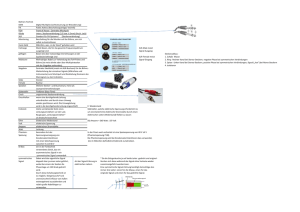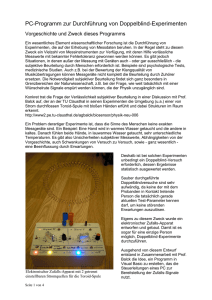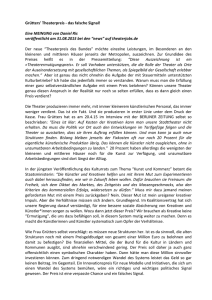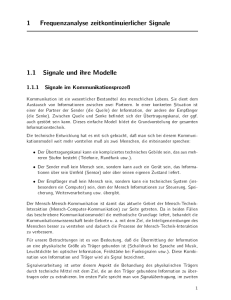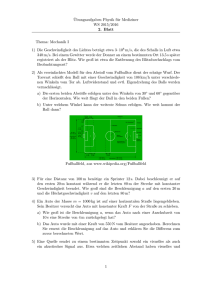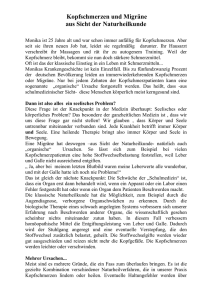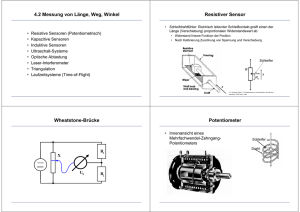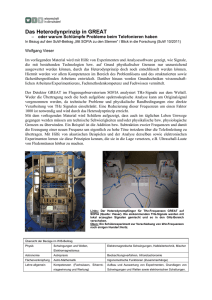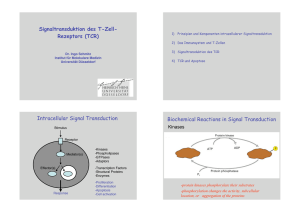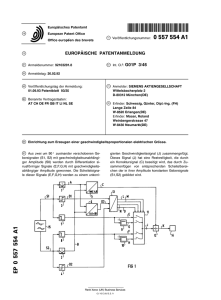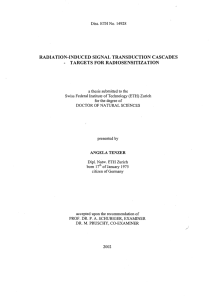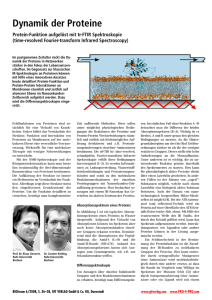Vorlesung: Molekulare Mechanismen der Signaltransduktion
Werbung
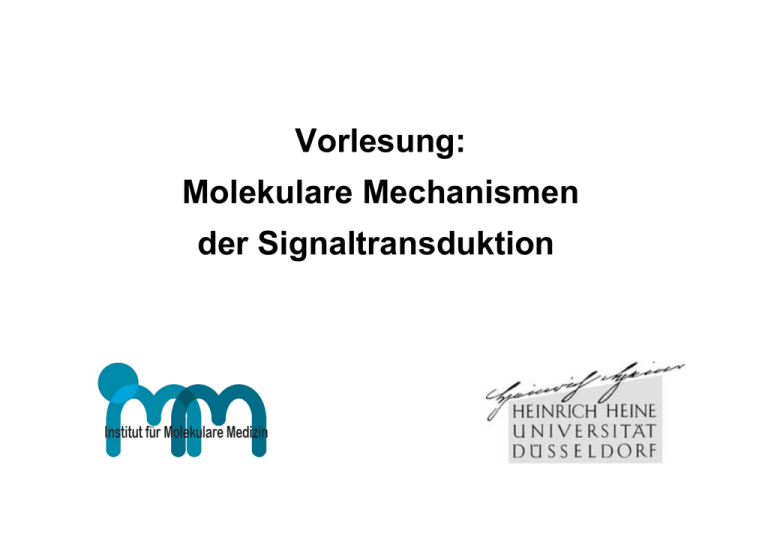
Vorlesung: Molekulare Mechanismen der Signaltransduktion Literatur Lehrbuch der Molekularen Zellbiologie von Bruce Alberts et al. Molekulare Zellbiologie 799 Seiten - Wiley-VCH Erscheinungsdatum: 13. September 2001 Auflage: 2. Aufl. ISBN: 3527304932 Preis: 59,00€ von Harvey Lodish ,Arnold Berk , S. L. Zipursky ,James Darnell Molekularbiologie der Zelle, m. CD-ROM von Bruce Alberts ,Alexander Johnson ,Julian Lewi 1300 Seiten - Spektrum Verlag Erscheinungsdatum: Oktober 2001 ISBN: 3827410770 Preis: EUR 79,95 1863 Seiten - Wiley-Vch Erscheinungsdatum: Dezember 2003 ISBN: 3527304924 Preis: 109,00€ Literatur Biochemie der Regulation und Signaltransduktion von Gerhard Krauss 522 Seiten - Wiley-VCH Verlag Erscheinungsdatum: Juli 1997 ISBN: 3527293930 Preis: 79,00€ (deutsch) Immunobiology, w. CD-ROM von Charles A. Janeway , Paul Travers ,Mark Walport 528 Seiten - Wiley-VCH Erscheinungsdatum: 17. Juli 2001 Auflage: 2. Aufl. ISBN: 3527303782 Preis: 89,00€ (englisch) Signal Transduction von Bastien Gomperts Sprache: Englisch Broschiert - 848 Seiten - Churchill Livingstone Erscheinungsdatum: Juli 2004 ISBN: 0443073104 EUR 62,00 424 Seiten - Academic Press Erscheinungsdatum: 1. März 2002 ISBN: 0122896319 Preis: 74.o5€ General Principles in Signal Transduction Signals Receptors Mediator(s) Effector(s) Response -Kinases -Phospholipases -GTPases -Adaptors -Transcription Factors -Structural Proteins -Enzymes -Proliferation -Differentiation -Apoptosis -Cell activation General Principles in Signal Transduction General Principles in Signal Transduction General Principles in Signal Transduction General Principles in Signal Transduction General Principles in Signal Transduction General Principles in Signal Transduction General Principles in Signal Transduction General Principles in Signal Transduction Signals Receptors Hydrophobic Signals Hydrophilic Signals Mediator(s) Intracellular Receptors Response General Principles in Signal Transduction Steroid Receptor Family • Cytoplasmic transcription factors • Bind lipophilic ligands – Estrogen, progesterone, testosterone – Vitamin D Steroid sex hormones – Glucocorticoids and mineralocorticoids – Thyroid hormone (nuclear receptor) Steroid Receptor Signaling Steroid Receptor Signaling Steroid Receptor Structure General Principles in Signal Transduction General Principles in Signal Transduction A B D C Different classes of cell surface receptors O. Modlich 24.5. J. Bode 3./10.5. nächste Woche W. Schulz 17.5. Two main apoptosis signaling pathways F. Essmann (14.6.) Death ligand Death receptor) FADD cytokines Bad TCR Bim p53 Puma Noxa Pro-Caspase-8 Bcl-2 Bcl-xLL Bid Caspase-8 (active) Bax Bak mitochondrium Caspase-9 Omi/HtrA2 AIF Smac/Diablo Cyt c Apaf-1 IAP cytoplasm Caspase-3 (executioner caspases) DFF/CAD Death Substrates Caspase-independent Death DNA Fragmentation nucleus General Principles in Signal Transduction Signals Hydrophilic Signals Receptors Mediator(s) Response General Principles in Signal Transduction -Kinases -Phospholipases -Second messengers -GTPases -Adaptors Biochemical Reactions in Signal Transduction Kinases -protein kinases phosphorylate their substrates -phosphorylation changes the activity, subcellular location, or aggregation of the proteins Biochemical Reactions in Signal Transduction Kinases Nucleophiler Angriff Energiegefälle: Kein Rückreaktion ! Biochemical Reactions in Signal Transduction Kinases Primary structure of a kinase Kinase domain ( approx. 30 kDa) Subdomains I II III IV V AXK VI VII VIII IX X XI Activation loop (T-loop) Tyr Kinases: Src, EGF-R, PDGF-R, JAK Ser/Thr Kinases: PKC, Raf, MAPK, Akt Dual-specificity kinases: MEK, MKK Lipid Kinase: PI3K General Principles in Signal Transduction -Kinases -Phospholipases -Second messengers -GTPases -Adaptors Biochemical Reactions in Signal Transduction Phospholipases -phospholipase C (PLC) catabolizes phospholipids (PIP2) generating IP3 -IP3 binds a receptor and increases cytosolic calcium -increased cytosolic calcium activates other signaling mechanisms General Principles in Signal Transduction -Kinases -Phospholipases -Second messengers -GTPases -Adaptors Second Messengers • Cyclic nucleotides – Cyclic AMP and cyclic GMP • Lipid metabolites – Diacylglycerol – Inositol triphosphate • Calcium General Principles in Signal Transduction -Kinases -Phospholipases -Second messengers -GTPases -Adaptors General Principles in Signal Transduction GTP-binding proteins in signal transduction a) G-Proteins (heterotrimeric GTPases) b) monomeric GTPases = small GTPases = ras-like GTPases G protein coupled receptors G proteinbild andreas Simm G protein coupled receptors Activation of Adenylate Cyclase by Gs G protein coupled receptors - cAMP generation Function of Adenylate Cyclase G protein coupled receptors - PKA activation Molecular Biology of the Cell, 2002 Activation of cAMP-dependent protein kinase (PKA) cAMP binds to the PKA regulatory subunits → conformational changes, which causes their dissociation from the catalytic subunits → kinase activation. Release of the catalytic subunits requires the binding of more than two cyclic AMP molecules greatly sharpening the response of the kinase to changes in [cAMP]. PKA is a Ser/Thr kinase with discrete substrate specificity, thus facilitating a cascade of highly regulated protein phosphorylations. General Principles in Signal Transduction GTP-binding proteins in signal transduction a) G-Proteins (heterotrimeric GTPases) b) monomeric GTPases = small GTPases = ras-like GTPases Biochemical Reactions in Signal Transduction GTPases GEFs GAPs Signal -G proteins are turned “on” and “off” by GTP and GDP, respectively - active G proteins transmit the signal to other “downstream” proteins Biochemical Reactions in Signal Transduction GTPases GTPases: Ras, Rac1, Rho, Cdc42 GEFs: Sos, Ras-GRP, Vav1 Vav1 General Principles in Signal Transduction -Kinases -Phospholipases -Second messengers -GTPases -Adaptors Biochemical Reactions in Signal Transduction Adaptor proteins Example: SH2 domains -recognize phosphoryated tyrosines -Recruit signaling proteins to receptor -adaptors have no enzymatic activity of their own -function is to recruit signaling enzymes to the receptor-ligand complex -this concentrates signaling proteins and increases efficiency Biochemical Reactions in Signal Transduction SH2 Adaptor Proteins • • • Example: SH2 domains -recognize phosphoryated tyrosines -Recruit signaling proteins to receptor Many proteins have a domain called SH2 Portion that recognizes phosphotyrosine Interacts with phosphotyrosine (like a ligand and receptor) xxxxxYxxxx P xxxxxYxxxx Biochemical Reactions in Signal Transduction Adaptor proteins Protein-protein interaction domains SH2 14-3-3 SH3 P -Y-X-X-hyPTB -P-X-X-P-X- R-S-X-S-X-P WW PH P -hy-X-N-P-X-Y- P -P-P-X-Y- PIP3 Biochemical Reactions in Signal Transduction Adaptor proteins Cytoplasmic adaptor proteins MW (kD) Interaction partners Expression Grb2 28 Sos,LAT,c-Cbl,Shc,SLP-76, Vav,SHP-2,WASP,HPK1 ubiquitous Grap 28 Sos,LAT,Shc,SAM68 B-Cells, T-Cells Name Structure PxxP Gads Nck-1 47 PxxP Shb PxxP Shc PxxP 40 PxxP SH2-Binding Site SH3-Binding Site 55,66 46,52,66 SH3-Domain T-Cells, NK Cells Mast cells. Macrophages, Thrombocytes Sos,SLP-76,WASP,PAK,Cbl ubiquitous LAT,Shc,SLP-76,HPK1 Grb2,LAT,PI3K,Eps8, PLCγ1,CD3ζ,Src Grb2,SHIP,ZAP-70,CD3ζ, Igα/β,RasGAP PTB-Domain ubiquitous ubiquitous SH2-Domain Biochemical Reactions in Signal Transduction Adaptor proteins Transmembrane adaptor proteins Name Structure MW (kD) Interaction partners Expression 36-38 Grb2,Gads,SLP-76, PLCγ1/2,c-Cbl,PI3K T-Cells, NK Cells, Mast cells, Platelets 75-85 Csk,Fyn Ubiquitous SIT 30-40 SHP2 B-Cells, T-Cells TRIM 29-30 PI3K T-Cells, NK Cells LAT PAG/Cbp PxxP PxxP TM PxxP SH2-Binding Site SH3-Binding Site A. Leo and B.Schraven, Current Opinion in Immunology, 2001 Next week: Signaling from receptor tyrosine kinases Stimulates Mitogen Activated Protein kinases (MAPK)
